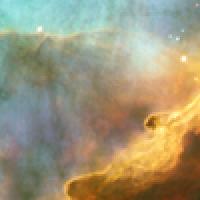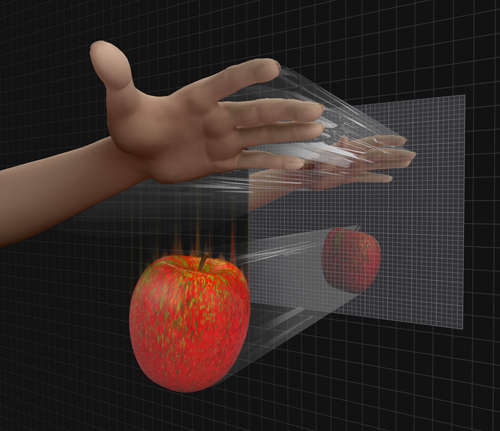
Strings, particles and the early Universe
This article is part of a series celebrating the 20th birthday of the Isaac Newton Institute in Cambridge. The Institute is a place where leading mathematicians from around the world can come together for weeks or months at a time to indulge in what they like doing best: thinking about maths and exchanging ideas without the distractions and duties that come with their normal working lives. And as you'll see in our articles, what starts out as abstract mathematics scribbled on the back of a napkin can have a major impact in the real world.
The Strong Fields, Integrability and Strings programme, which took place at the Isaac Newton Institute in 2007, explored an area that would have been close to Isaac Newton's heart: how to unify Einstein's theory of gravity, a continuation of Newton's own work on gravitation, with quantum field theory, which describes the atomic and sub-atomic world, but cannot account for the force of gravity. The strongest contender for such a unified theory of quantum gravity is string theory, but to date string theory remains purely theoretical – it cannot be tested in the laboratory and its relation to other areas of physics is unclear. (Find out more about string theory in From Newton to Einstein and beyond and Tying it all up.)

One interpretation of the AdS/CFT correspondence is that the universe is akin to a hologram. Find out more...
The programme set out to explore a remarkable breakthrough made by the physicist Juan Maldacena in the late 1990s. String theory and quantum field theory had traditionally been separate areas within physics, but Maldacena proposed an exact mathematical correspondence between the two. This result, known as the AdS/CFT correspondence or the holographic principle, suggests that the two theories are in fact equivalent, and opens up tantalising possibilities: perhaps long-standing problems from one theory can be translated into problems in the other, where they might be easier to solve. The technique promises to shed light on a range of fundamental physical questions, from the beginning of the Universe to a precise mathematical understanding of particle physics. (You can find out more about the AdS/CFT correspondence in the Plus article The illusory Universe.)
Unravelling the AdS/CFT correspondence has generated massive interest within physics over the last ten years. "One of the main motivations of the programme was to bring together researchers working on both sides of the AdS/ CFT correspondence," says Nick Dorey, who co-organised the programme. The Isaac Newton Institute is the ideal venue for such a meeting of minds: its reputation attracts topranking researchers from around the world, and with a six-month programme, provides the time and space for ideas to flourish.
Gravity and fluid motion
One ground-breaking result that emerged from the programme gives a glimpse of the early Universe by connecting two of the most famous sets of equations in physics: Einstein's equations describing gravity and the Navier–Stokes equations describing fluid dynamics. "One of our main results accomplished at the programme was to show that there is a precise sense in which these two equations are related," says Mukund Rangamani, who led this particular strand of research with his coworkers Sayantani Bhattacharyya, Veronika Hubeny and Shiraz Minwalla. As a result, Einstein's equations, which are notoriously difficult to solve, can be attacked using solutions to the Navier–Stokes equations and vice versa. (Find out more about the Navier-Stokes equations in How maths can make you rich and famous.)
The new gravity/fluid correspondence is relevant to the quark-gluon plasma, an extremely hot and dense soup of particles, which filled the early Universe for just a few microseconds after the Big Bang. Using heavy ion collisions, physicists at the Relativistic Heavy Ion Collider in the US have recently been able to produce this quark-gluon plasma (and the Large Hadron Collider at CERN will soon embark on a similar project). However, as Dorey points out, "none of our conventional methods based on traditional particle physics are effective in understanding this soup of quarks and gluons theoretically." Here the clarification of the relation between gravity and fluid dynamics may come to the rescue, enabling crucial calculations that can shed light on this mysterious substance.
Solving supersymmetry
The programme also produced important progress on the mathematical underpinnings of both quantum field theory and string theory. The two models perform remarkably well, but there are theoretical aspects of both that remain unclear. In fact, a complete mathematical resolution of the quantum field theory that underlies the standard model of particle physics, called Yang–Mills theory, is considered one of the hardest open problems in mathematics. Whoever achieves it is set to win a $1 million prize from the Clay Mathematics Institute.

Can the AdS/CFT correspondence help us solve the mysteries of the Universe? Image: NASA Marshall Space Flight Center.
In a combined effort, researchers at the programme provided solutions to a problem pertaining to both sides of the AdS/CFT correspondence. On one side was a particular version of string theory and on the other a special case of a supersymmetric Yang- Mills theory, known as N=4SYM, which assumes a special kind of symmetry, called supersymmetry, as an extra constraint. "Solving these theories is extremely important and the work provides a major step in that direction," explain Nikolay Gromov, Vladimir Kazakov and Pedro Vieira, who led the research. "Understanding string theory is currently our best hope towards a unified theory of quantum gravity. Solving N=4SYM for the first time will improve dramatically our understanding of the quantum field theory which governs the constituents of atomic nuclei."
Furthermore, solving both sides of the AdS/CFT correspondence can help illuminate what this correspondence, which is after all a mathematical object, really says about the nature of physical laws.
"This work [on the AdS/CFT correspondence] was the culmination of an outstanding endeavour involving hundreds of people working in the field," say Gromov and his co-workers. "Importantly, many of them participated in the programme, making their expertise available to us."
In total, 254 researchers benefited from the fertile "breeding ground", as Dorey describes it, which the programme provided. Participants produced a host of highly cited academic papers, presenting the results mentioned here and many others besides. Most importantly, their work inspired avid and ongoing research into several aspects of the field. One day the results from this research may reveal the exact nature of physical reality, which, despite Isaac Newton's own revolutionary work, has so far remained elusive.